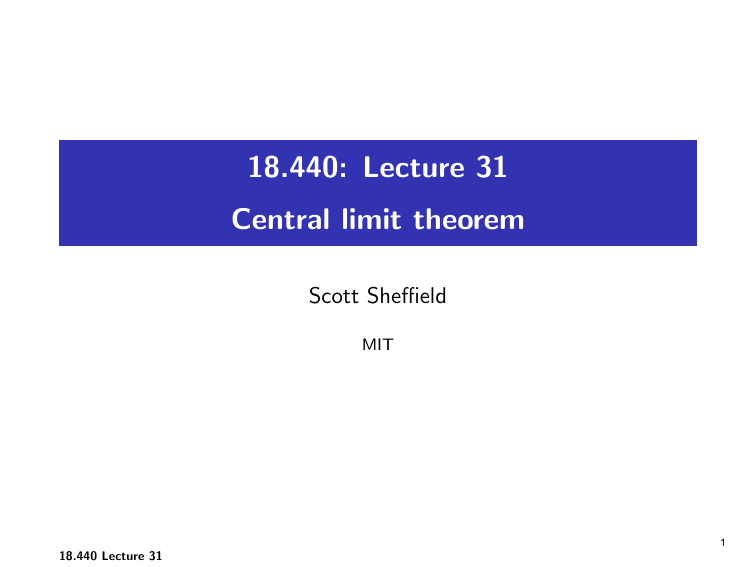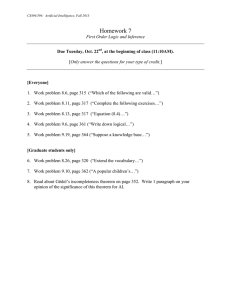18.440: Lecture 31 Central limit theorem Scott Sheffield MIT
advertisement

18.440: Lecture 31
Central limit theorem
Scott Sheffield
MIT
1
18.440 Lecture 31
Outline
Central limit theorem
Proving the central limit theorem
2
18.440 Lecture 31
Outline
Central limit theorem
Proving the central limit theorem
3
18.440 Lecture 31
Recall: DeMoivre-Laplace limit theorem
I
I
I
Let XiPbe an i.i.d. sequence of random variables. Write
Sn = ni=1 Xn .
Suppose each Xi is 1 with probability p and 0 with probability
q = 1 − p.
DeMoivre-Laplace limit theorem:
Sn − np
≤ b} → Φ(b) − Φ(a).
lim P{a ≤ √
npq
n→∞
I
I
I
I
Here Φ(b) − Φ(a) = P{a ≤ Z ≤ b} when Z is a standard
normal random variable.
S√
n −np
npq describes “number of standard deviations that Sn is
above or below its mean”.
Question: Does a similar statement hold if the Xi are i.i.d. but
have some other probability distribution?
Central limit theorem: Yes, if they have finite variance.
18.440 Lecture 31
4
Example
I
Say we roll 106 ordinary dice independently of each other.
P106
Let Xi be the number on the ith die. Let X = i=1
Xi be the
total of the numbers rolled.
I
What is E [X ]?
I
What is Var[X ]?
I
How about SD[X ]?
I
What is the probability that X is less than a standard
deviations above its mean?
Ra
2
Central limit theorem: should be about √12π −∞ e −x /2 dx.
I
I
5
18.440 Lecture 31
Example
I
Suppose earthquakes in some region are a Poisson point
process with rate λ equal to 1 per year.
I
Let X be the number of earthquakes that occur over a
ten-thousand year period. Should be a Poisson random
variable with rate 10000.
I
What is E [X ]?
I
What is Var[X ]?
I
How about SD[X ]?
I
What is the probability that X is less than a standard
deviations above its mean?
Ra
2
Central limit theorem: should be about √12π −∞ e −x /2 dx.
I
6
18.440 Lecture 31
General statement
I
I
I
I
Let Xi be an i.i.d. sequence of random variables with finite
mean µ and variance σ 2 .
Pn
Write Sn = i=1
Xi . So E [Sn ] = nµ and Var[Sn ] = nσ 2 and
√
SD[Sn ] = σ n.
√ n −nµ . Then Bn is the difference
Write Bn = X1 +X2 +...+X
σ n
between Sn and its expectation, measured in standard
deviation units.
Central limit theorem:
lim P{a ≤ Bn ≤ b} → Φ(b) − Φ(a).
n→∞
7
18.440 Lecture 31
Outline
Central limit theorem
Proving the central limit theorem
8
18.440 Lecture 31
Outline
Central limit theorem
Proving the central limit theorem
9
18.440 Lecture 31
Recall: characteristic functions
I
Let X be a random variable.
I
The characteristic function of X is defined by
φ(t) = φX (t) := E [e itX ]. Like M(t) except with i thrown in.
I
Recall that by definition e it = cos(t) + i sin(t).
I
Characteristic functions are similar to moment generating
functions in some ways.
I
For example, φX +Y = φX φY , just as MX +Y = MX MY , if X
and Y are independent.
I
And φaX (t) = φX (at) just as MaX (t) = MX (at).
I
And if X has an mth moment then E [X m ] = i m φX (0).
I
Characteristic functions are well defined at all t for all random
variables X .
(m)
10
18.440 Lecture 31
Rephrasing the theorem
I
Let X be a random variable and Xn a sequence of random
variables.
I
Say Xn converge in distribution or converge in law to X if
limn→∞ FXn (x) = FX (x) at all x ∈ R at which FX is
continuous.
I
Recall: the weak law of large numbers can be rephrased as the
n
statement that An = X1 +X2 +...+X
converges in law to µ (i.e.,
n
to the random variable that is equal to µ with probability one)
as n → ∞.
I
The central limit theorem can be rephrased as the statement
√ n −nµ converges in law to a standard
that Bn = X1 +X2 +...+X
σ n
normal random variable as n → ∞.
18.440 Lecture 31
11
Continuity theorems
I
Lévy’s continuity theorem (see Wikipedia): if
lim φXn (t) = φX (t)
n→∞
for all t, then Xn converge in law to X .
I
By this theorem, we can prove the central limit theorem by
2
showing limn→∞ φBn (t) = e −t /2 for all t.
I
Moment generating function continuity theorem: if
moment generating functions MXn (t) are defined for all t and
n and limn→∞ MXn (t) = MX (t) for all t, then Xn converge in
law to X .
I
By this theorem, we can prove the central limit theorem by
2
showing limn→∞ MBn (t) = e t /2 for all t.
12
18.440 Lecture 31
Proof of central limit theorem with moment generating
functions
I
I
I
I
I
I
I
I
Write Y = X σ−µ . Then Y has mean zero and variance 1.
Write MY (t) = E [e tY ] and g (t) = log MY (t). So
MY (t) = e g (t) .
We know g (0) = 0. Also MY0 (0) = E [Y ] = 0 and
MY00 (0) = E [Y 2 ] = Var[Y ] = 1.
Chain rule: MY0 (0) = g 0 (0)e g (0) = g 0 (0) = 0 and
MY00 (0) = g 00 (0)e g (0) + g 0 (0)2 e g (0) = g 00 (0) = 1.
So g is a nice function with g (0) = g 0 (0) = 0 and g 00 (0) = 1.
Taylor expansion: g (t) = t 2 /2 + o(t 2 ) for t near zero.
Now Bn is √1n times the sum of n independent copies of Y .
√ n
ng ( √t n )
So MBn (t) = MY (t/ n) = e
.
ng ( √t )
n( √t )2 /2
n ≈ e
n
But e
= et
2
e t /2 as n tends to infinity.
18.440 Lecture 31
2 /2
, in sense that LHS tends to
13
Proof of central limit theorem with characteristic functions
I
Moment generating function proof only applies if the moment
generating function of X exists.
I
But the proof can be repeated almost verbatim using
characteristic functions instead of moment generating
functions.
I
Then it applies for any X with finite variance.
14
18.440 Lecture 31
Almost verbatim: replace MY (t) with φY (t)
I
Write φY (t) = E [e itY ] and g (t) = log φY (t). So
φY (t) = e g (t) .
I
We know g (0) = 0. Also φ0Y (0) = iE [Y ] = 0 and
φ00Y (0) = i 2 E [Y 2 ] = −Var[Y ] = −1.
I
Chain rule: φ0Y (0) = g 0 (0)e g (0) = g 0 (0) = 0 and
φ00Y (0) = g 00 (0)e g (0) + g 0 (0)2 e g (0) = g 00 (0) = −1.
I
So g is a nice function with g (0) = g 0 (0) = 0 and
g 00 (0) = −1. Taylor expansion: g (t) = −t 2 /2 + o(t 2 ) for t
near zero.
I
Now Bn is
I
I
√1
n
times the sum of n independent copies of Y .
√ n
ng ( √t n )
So φBn (t) = φY (t/ n) = e
.
ng ( √t )
−n( √t )2 /2
n ≈ e
n
But e
= e −t
2 /2
−t
to e
as n tends to infinity.
2 /2
, in sense that LHS tends
15
18.440 Lecture 31
Perspective
I
The central limit theorem is actually fairly robust. Variants of
the theorem still apply if you allow the Xi not to be identically
distributed, or not to be completely independent.
I
We won’t formulate these variants precisely in this course.
I
But, roughly speaking, if you have a lot of little random terms
that are “mostly independent” — and no single term
contributes more than a “small fraction” of the total sum —
then the total sum should be “approximately” normal.
I
Example: if height is determined by lots of little mostly
independent factors, then people’s heights should be normally
distributed.
I
Not quite true... certain factors by themselves can cause a
person to be a whole lot shorter or taller. Also, individual
factors not really independent of each other.
I
Kind of true for homogenous population, ignoring outliers.
18.440 Lecture 31
16
MIT OpenCourseWare
http://ocw.mit.edu
18.440 Probability and Random Variables
Spring 2014
For information about citing these materials or our Terms of Use, visit: http://ocw.mit.edu/terms.



